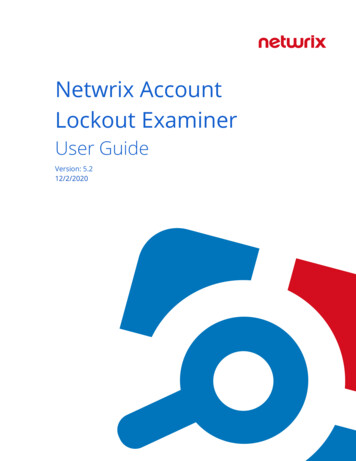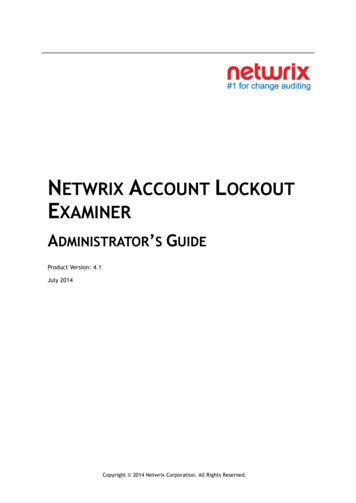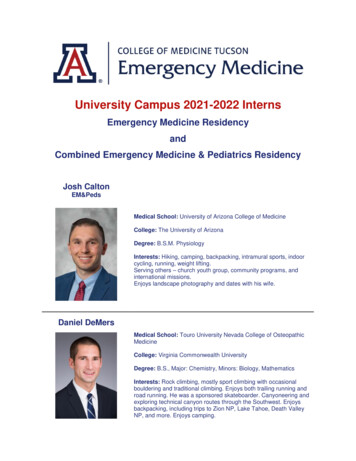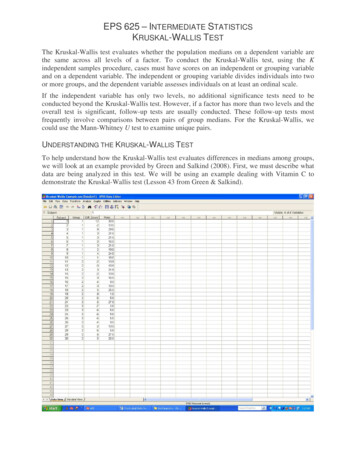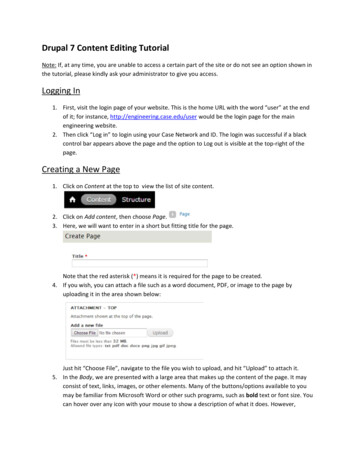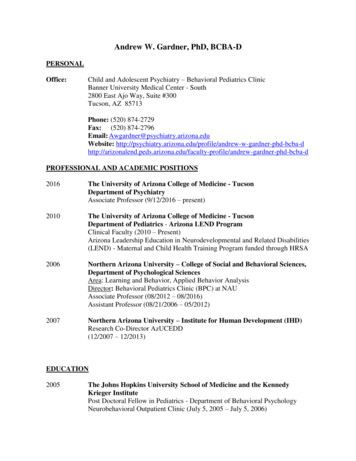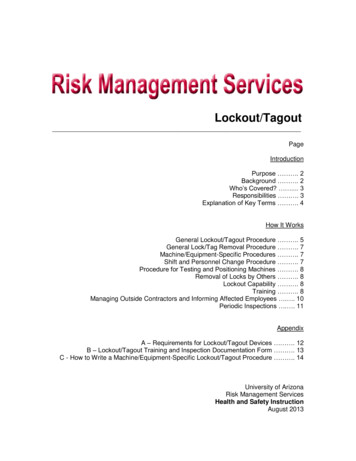
Transcription
Lockout/TagoutPageIntroductionPurpose . 2Background . 2Who’s Covered? . 3Responsibilities . 3Explanation of Key Terms . 4How It WorksGeneral Lockout/Tagout Procedure . 5General Lock/Tag Removal Procedure . 7Machine/Equipment-Specific Procedures . 7Shift and Personnel Change Procedure . 7Procedure for Testing and Positioning Machines . 8Removal of Locks by Others . 8Lockout Capability . 8Training . 8Managing Outside Contractors and Informing Affected Employees . . 10Periodic Inspections . . 11AppendixA – Requirements for Lockout/Tagout Devices . 12B – Lockout/Tagout Training and Inspection Documentation Form . 13C - How to Write a Machine/Equipment-Specific Lockout/Tagout Procedure . 14University of ArizonaRisk Management ServicesHealth and Safety InstructionAugust 2013
Page 2Health and Safety InstructionINTRODUCTIONPURPOSEThe purpose of this Health and Safety Instruction (HSI) is to prevent injury toemployees by potentially hazardous energy when machines or equipment arebeing repaired or serviced.BACKGROUNDFailure to control potentially hazardous energy during equipment repair or serviceaccounts for nearly 10 percent of the serious accidents in the workplace. Typicalinjuries include fractures, lacerations, contusions, amputations and puncturewounds. To control or eliminate this hazard, the Occupational Safety and HealthAdministration (OSHA) issued the Control of Hazardous Energy Standard (29CFR 1910.147), also known as the “Lockout/Tagout Standard.” It requires that: Energy sources for equipment be turned-off or disconnected.The switch either be locked or labeled with a warning tag.The equipment cleared of personnel, tools and other items.The effectiveness of the lockout and/or tagout tried by operating the on/offswitch to confirm that the equipment does not start.Under the Control of Hazardous Energy Standard, the University of Arizona(UA) is required to: Establish a written Energy Control Plan which tells how to lockout andtagout equipment to prevent injury to employees performing repairs orservice (i.e., Lockout Tagout Program).Provide training to ensure employees understand the Lockout/TagoutProgram and know how to perform lockout/tagout procedures safely.Conduct periodic inspections of specific lockout/tagout procedures toensure that they are being followed faithfully and safely.This HSI, developed by Risk Management Services serves as the University ofArizona’s written Energy Control Plan. It outlines the minimum requirements fordisabling machines or equipment to ensure that all potentially hazardous energyis isolated before any servicing or maintenance activities are conducted. It alsooutlines the minimum requirements for achieving compliance with OSHA’sControl of Hazardous Energy Standard.LOCKOUT/TAGOUTOctober 2013
Page 3Health and Safety InstructionWHO’S COVERED?Employees are covered by this HSI if they are involved with service andmaintenance on machines or equipment where the unexpected energization,start-up, or release of stored energy could cause injury. This includes AffectedEmployees, Authorized Employees, and Owners.Employees are not covered by this HIS if they are involved with: Work on cord and plug connected electric equipment when it is unpluggedand the employee working on the equipment has complete control over theplug.Hot tap operations involving gas, steam, water or petroleum products, whenthey are performed on pressurized pipelines; when continuity of service isessential and shutdown of the system is impractical and employees areprovided with an alternative type of protection that is equally effective.Normal production operations and minor servicing tasks including repetitive,routine, minor adjustments (e.g., tool changes and adjustments), andmaintenance (e.g., lubricating, cleaning, unjamming) when the power-oncondition is essential to accomplish a particular task and when alternativemeasures that give effective protection are employed.RESPONSIBILITIESSafety is a line-management function. The core of the document is color-coded asbelow to clearly identify who is responsible for the various aspects of the Program: Management is ultimately responsible for implementation of the HazardCommunication Program, including ensuring that those under their controlhave the authority and resources to implement the Program, and forensuring that areas under their charge are in compliance with the Program. Supervision is operationally responsible for implementation of theProgram, and Employees are responsible for following rules and working safely. Risk Management Services is a technical resource to line-management.LOCKOUT/TAGOUTOctober 2013
Page 4Health and Safety InstructionEXPLANATION OF KEY TERMSPotentially hazardous energy includes electrical, mechanical, hydraulic,pneumatic, chemical, thermal or other similar energies capable of causing bodilyharm.Energy isolating device includes all switches, valves, circuit breakers or otherdevices that serve to shut off the supply of energy to machinery or equipment(push buttons, selector switches and other control circuit type devices are notenergy isolating devices).An Affected Employee is any employee whose job requires him/her to operateor use machinery or equipment on which servicing or maintenance is beingperformed under lockout/tagout or whose job requires him/her to work in an areain which such work is being performed.An Authorized Employee is a person who puts the lock on machines orequipment to perform the servicing or maintenance on that machine orequipment. An affected employee becomes an authorized employee when thatemployee’s duties include performing servicing or maintenance.The Owner is the principal authorized employee who is primarily responsible forthe piece of machinery or equipment during servicing or maintenance.LOCKOUT/TAGOUTOctober 2013
Page 5Health and Safety InstructionHOW IT WORKSGENERAL LOCKOUT/TAGOUT PROCEDUREThis procedure must be followed in sequence by authorized employees torender a piece of equipment safe for personal contact:First-line supervisors are responsible for providing proper locks, tags andlockout devices for their authorized employees (see Appendix A for a list ofspecifications of proper locks, tags and lockout devices).Get Ready1. Let all affected employee know you will be locking and/or tagging out themachine or equipment and why.2. Identify potential hazardous energies associated with the machine orequipment3. Locate the switches, valves, circuit breakers or other main disconnect, energyisolating devices for each potentially hazardous energy.4. Shutdown the machine or equipment by normal procedures, if in operation orservice.5. Deactivate (turn off) all switches, valves, circuit breakers or other energyisolating devices. Be sure the machine or equipment is isolated from allpotentially hazardous energies.6. Dissipate or restrain any stored energy. Energy may be stored in springs,elevated machine parts, rotating flywheels, hydraulic systems, and air, gas,steam or water pressure. Use methods such as repositioning, blockingmovement or bleeding pressure.LockApply appropriate lockout devices and/or locks to all energy isolating devices.This ensures they are held in a “safe” or “off” position and that no person orunforeseen action can start or activate the machine or release potentiallyhazardous energy from the equipment.Lockout devices and locks may be omitted, but only if the energy isolating deviceis not capable of being lock-out.If a tag alone is used, additional safety measures that can provide the same levelof safety as a lock must be employed. This might include removing and isolatinga circuit element, blocking access to a controlling switch or removing a valvehandle to reduce the potential for any inadvertent activation.LOCKOUT/TAGOUTOctober 2013
Page 6Health and Safety InstructionTag1. Alert everyone that the machine or equipment is not in service by attaching aproper tag to all locks or energy isolating devices (in the case where lockscannot be used).2. Write your name, the date and the purpose for the lockout/tagout on the tag.Clear1. Clear the area around the equipment of personnel, tools and other nonessential items.2. Ensure that all guards are in place.Try1. Try or test the operating controls to make sure that the machine or equipmentwill not operate or release other potentially hazardous energies. If work involves electrical conductors or circuit parts, a qualified person(i.e., one who is knowledgeable in electrical hazards and safetymeasures) must verify the absence of voltage. Test equipment must bechecked for proper operation immediately before and after this test (i.e.,3-point testing) and appropriate shock and arc flash protective equipment,specific for the tasks to be performed, must be used when testing (seeNFPA 70E 2012). Interlocked equipment must be checked carefully to make sure that theequipment is lockout out properly and not temporarily inoperativebecause of an interlock.2. Return the energy isolating device(s) to their “off” or “safe” position.The equipment has now been locked and/or tagged out by the owner (i.e., theprinciple authorized employee). Any other authorized employees wishing towork on this machine or equipment must apply their own locks and/or tags and,after all personnel are clear of the equipment, must try the effectiveness of thelockout/tagout before commencing work. This means, if there are 10 peopleworking on the machine at any one time, there will be 10 locks and/or tags on theenergy isolating devices (for example by using multi-lock hasps), unless theowner uses a group lock out system, such as a lock box, where he/she performslockout/tagout on the machine and places his/her keys in a lock box and otherauthorized employees verify lockout/tagout of the machine and place their locksand tags on the lock box.LOCKOUT/TAGOUTOctober 2013
Page 7Health and Safety InstructionGENERAL LOCK/TAG REMOVAL PROCEDUREThis procedure must be followed in sequence by authorized employees toremove locks and/or tags and restore energy to the machine or equipment.1. Clear the equipment and the area around the equipment of personnel, toolsor other non-essential items.2. Ensure that all guards are in place.3. Remove locks, lockout devices and/or tags. Only the same authorized employee who installed the lock(s) and/ortag(s) may remove them (There are limited exceptions which aredescribed under, “Removal of Locks by Others”). If more than one authorized employee is involved in the lockout/tagoutprocedure, the owner must be the last to remove their lock(s) and/ortag(s).4. The owner must restore energy to the machine or equipment and confirmthat the equipment is operational.5. The owner must let all affected employees know that the machine orequipment is operational again.MACHINE/EQUIPMENT-SPECIFIC PROCEDURESFirst-line supervisors must develop and document specific lockout/tagout andlock/tag removal procedures for each covered activity (see page 3 and AppendixC - How to Write a Machine/Equipment-Specific Lockout/Tagout Procedure).Exception: Specific, written procedures are not required when all the followingelements exist: There is no potential for stored energy. There is only a single energy source and it is easily identified and isolated bya single lockout device. Isolation results in complete deenergization. Lockout is under the compete control of the authorized employee. There is no history of accidents with the specific machine or equipment beingserviced or maintained.SHIFT OR PERSONNEL CHANGE PROCEDUREThis procedure must be followed in sequence by authorized employees whenlockout/tagout-related work is to extend beyond the original shift andlockout/tagout must change ownership.1. All authorized employees involved in the lockout/tagout musts remove theirlock(s) and/or tag(s). The lock(s) and/or tag(s) of the current owner from theoriginal shift must remain on the equipment.2. The new owner must then perform a lockout/tagout in accordance with thisHSI.3. The current owner transfers the lockout/tagout responsibility to the newowner (from the subsequent shift) by removing their lock(s) and/or tag(s).LOCKOUT/TAGOUTOctober 2013
Page 8Health and Safety InstructionPROCEDURE FOR TESTING AND POSITIONING OF MACHINESWhen lockout/tagout must be interrupted to allow for testing or repositioning ofequipment, the authorized employee must complete the following procedure:1.2.3.4.5.Clear the machine or equipment of tools and/or materials.Clear the machine or equipment of personnel.Remove the lockout and tagout devices.Proceed with test, repositioning, etc.If the maintenance or servicing is not complete, de-energize the machine orequipment as in the lockout/tagout procedure and reinstall all lockout and/ortagout devices.REMOVAL OF LOCKS/TAGS BY OTHERSIf the authorized employee is still on site, or not known to have left the site, thatemployee’s locks and/or tags must not be removed by any other person. Duringan emergency while the authorized employee is off site, the authorizedemployee’s immediate supervisor or other member of the line organizationabove them can remove their lock and/or tag after a complete check of theequipment to determine that no hazard can result from the lock and/or tagremoval.The authorized employee must be informed that their lock and/or tag wasremoved before their return to workLOCKOUT CAPABILITYWhenever existing machines or equipment undergo major replacement, repair,renovation, modification, and whenever new machines or equipment areinstalled, the employee responsible for the work or design must ensure thatthe machines or equipment have, or are made to have, lockable energy isolatingdevices.TRAININGFirst-line supervisors are responsible for providing lockout/tagout trainingbefore employees are allowed to be involved in the servicing and maintenance ofmachines or equipment. All authorized employees must be tr
Any other authorized employees wishing to work on this machine or equipment must apply their own locks and/or tags and, after all personnel are clear of the equipment, must try the effectiveness of the lockout/tagout before commencing work. This means, if there are 10 people working on the machine at any one time, there will be 10 locks and/or tags on the energy isolating devices (for example .
